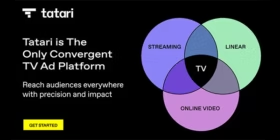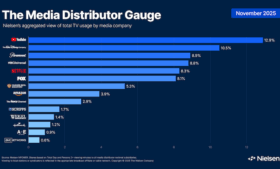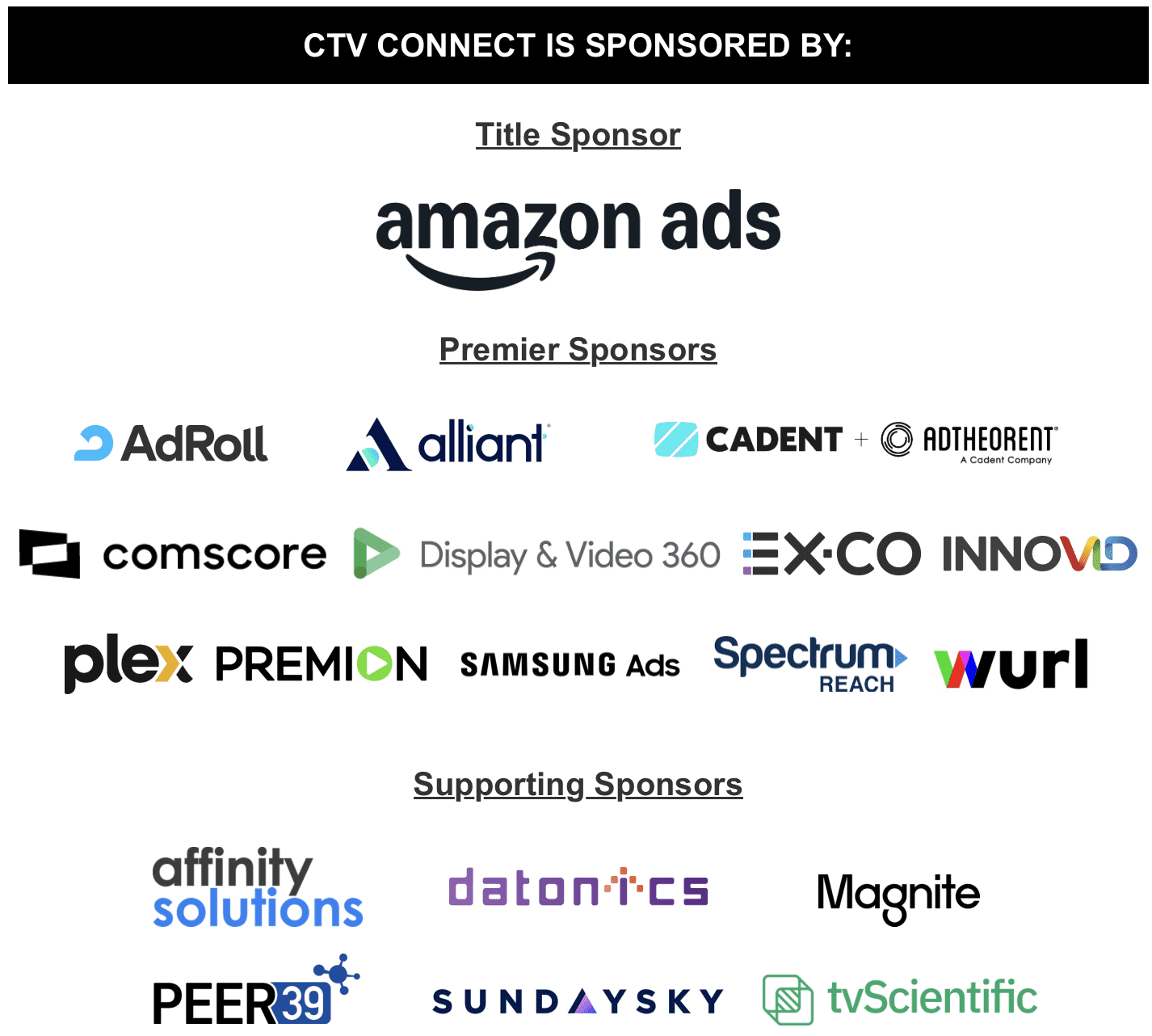| CTV Connect 2025: Key Takeaways from the Industry’s Leaders
By E.B. Moss
Connected TV (CTV) is no longer the future—it’s the present. Over two packed days at CTV Connect, media leaders, brand marketers, and tech innovators gathered to cheer the industry’s opportunities and address the obstacles, from transparency and measurement gaps to AI-driven ad buying and the growing intersection of streaming and e-commerce. With major brands shifting ad dollars from linear TV to streaming, the call for better data, smarter creative, and seamless buying solutions was loud and clear.
In keynotes, panels, and breakout sessions, brands like Inspire, ADT, and The Wine Group shared how they are redefining success metrics and optimizing their campaigns for performance—not just reach. Industry experts debated the state of CTV measurement and currency, and as AI continues to reshape the ad landscape, many, including Netflix, Amazon, and Roku, laid out how automation is fueling smarter audience targeting and better outcomes for advertisers.
Below, we break down the most essential takeaways from the event: what brands demand, where CTV is headed, and what’s leading to – or standing in the way of progress.
Why …and Where… Brands Are Shifting to CTV
Inspire Inspired.
Inspire Brands, the parent company of brands like Dunkin’, Arby’s, and Sonic, set the conference tone: Naming CTV as their biggest ad channel this year, with transparency a non-negotiable.
Travis Freeman, Chief Media Officer, didn’t hold back in outlining what the brand needs from its media partners:
“Push for maximum transparency, unified measurement and clean scale. It is mind-blowing how big this channel [OTT/streaming] is and how little information we as brand marketers and our agency partners are getting.”
So, their dollars come with demands: pod position, show-level data, time of day, and region-specific insights. They aim for every impression to count—dubbing their own measurement model the “ICPM”, or the Inspire CPM.
ADT Finds Security in Data-Meets-Contextual CTV Shift
The shift from linear TV to CTV is about reimagining both KPI-driven metrics and connecting with audiences through contextually relevant content. DeLu Jackson, Chief Marketing and Communications Officer at ADT, speaking with Bob Lord, President of Horizon Media, said:
“We moved away from traditional media metrics and marketing cost per installation as the primary currency for decision-making,” opting more for a performance-based approach tied directly to actual installations. “We were really strong with our core audience [using linear],” he added, “but we were losing next generation buyers. …Now our metrics are moving the right direction.”
They also created custom integrations with contextually relevant content that made sense for the home security company, such as “Only Murders in the Building” on Hulu. They found ways to be aligned with the Olympics, too, filming installs in the homes of traveling athletes who voiced, “for me to be my best when I’m on the road, I need to know that what I have at home is protected.”
Lord emphasized this rapid transition:
“In June ’24 we were 70% linear and 30% CTV. By the end of ’25 we will be 20% linear / 80% CTV…. We were showing direct impact on installs moving to CTV. So, it was easy to justify that, versus ‘how many impressions did we get?’ We have to move away from those metrics.”
Context is King
Speaking later in the day, Kay Wesolowski, SVP Investment and Partnerships, KSM Media, added color to the balance of linear and CTV, with a reminder to consider both contextual spaces and accurate data:
“I do think that we’ve gone a little far into that realm of assuming that data is accurate in every instance, or they should not be tested to confirm that that’s the right route to go. And there is still a role for thinking about CTV, of looking at broader audiences, of understanding context. Context has been significantly underutilized in the CTV space.
Amazon’s 4 Ps for CTV Advertising
Brian Tomasette, Director of Product & Engineering at Amazon Ads, which is aggressively expanding its ad tech capabilities, touted their new solutions, like Complete TV, to help advertisers plan and optimize linear and CTV campaigns together, and promoted the value of programmatic, too. He cast bit of side eye on marketers who question CTV’s scale, “wondering if they can grow their business against an audience of 1.7 billion global users” (projected by 2027). He summarized the four key pillars of a successful CTV ad product:
· Personalization – Delivering the right ad to the right consumer at the right time, at scale.
· Performance – Ensuring that ads drive measurable outcomes, a core value for Amazon.
· Portfolio Supply – Extending ad reach beyond Amazon Fire TV and Prime Video to major publishers, exchanges, and devices—including Roku.
· Privacy – Maintaining user trust by balancing data-driven insights with strong privacy protections.
Three Ms of Planning
In a session on Media Mix Modeling with David Nyurenberg, Director of Video Product Development & Innovation, and Sara Moorthy, Managing Partner, Advanced Analytics, both of Rain the Growth Agency, their recommended MMM best practices are to get Involved from the beginning and ask:
· What insights you need to optimize your media investment
· Did your strategies change over the course of the analysis timeframe?
· CTV’s latent impact on sales channels (DTC – Amazon – Retail) can vary
· How is CTV planned in conjunction with linear TV?
The Middle Ground
In his session with Wesolowski, Chris Novak, Chief Operating Officer, Eden Collective, asks how CTV and linear audiences come together and the cost of reaching them:
“The nice thing about CTV is that it affords us the opportunity to evaluate costs with targeting layered in. This allows brands to determine whether CTV’s higher CPMs are worthwhile or if they’re better off going broad with Linear, gaining the benefit of that spill outside the core target, and ultimately focusing on broader reach.”
Wesolowski added, speaking again, to the need for balance:
“I think the struggle is that certain metrics, FAST metrics, are available so easily, so quickly, that we’ve started to train clients to look at these metrics, and suddenly we’re opting out of places, and maybe you shouldn’t be opting out of, or we’re foregoing what it takes to actually build a brand over time.
When you’re trying to reach a new customer, and you want them to take a new action, that takes reach and frequency, and that’s not going to happen with the first impression or the second impression.”
Speaking of costs, in his session on Resold TV Chris Kane, Founder, Jounce Media, emphasized the financial burden of resold CTV inventory, While he doesn’t like the phrase, he said the math proves we do, in fact, have an “Ad Tech Tax” and screened a calculation that shows reselling adds a 39% premium, increasing the median floor price from $14 to $19.50.
Kane urged buyers to scrutinize programmatic supply chains and prioritize direct deals with trusted publishers:
“Streaming services like Hulu and Disney tightly control reselling, which prevents excessive fees and ad fraud. But in open marketplaces, advertisers can face higher costs and reduced transparency.”
Buying, Selling, Measurement & Transparency Challenges
Data Data Data Data
A breakout session from Samsung Ads detailed the four key values of data:
· Omniscience – Gaining full visibility into the media landscape.
· Crystallizing complex information – Making large sets of data actionable.
· Directing resources efficiently – Allocating budgets and optimizing spend.
· Shining a light on approaches – Understanding where improvements can be made.
A Marriage of Currency and Convenience
What do you get when you combine Spectrum’s TV app – the most watched streaming service in the U.S., with 115 million set-top boxes, and LinkedIn’s deterministic data, verified through user logins, offering precise targeting? A collaboration that aims to enhance B2B advertising by integrating LinkedIn’s professional data with Spectrum’s CTV scale. This session emphasized the importance of first-party data and a seamless, automated process for setting up CTV campaigns, highlighting the potential for future expansion and refinement of the model.
Dan Callahan, GVP, National Sales, Spectrum Reach, explained:
“LinkedIn has a DSP. It’s a self-serve thing. Spectrum Reach is set up programmatically: we’ve got first party data match that allows them to size and forecast these audiences. It’s as easy as saying ‘I want to reach this audience, and I want to include CTV on Spectrum’, and you’ll begin to see what that looks like for the flight, for your budget. …This model can exist for a variety of businesses. Like Retail Media. If you’ve got first party data, and you’re working in display or digital, there’s ways to expand it to CTV.”
The Call for Unified Measurement
Measurement remains one of the biggest challenges for CTV advertisers, who struggle with fragmentation and inconsistent reporting across platforms. As more ad dollars shift to CTV, marketers are demanding the same level of transparency they expect from linear TV. Yet, as Travis Freeman (Inspire Brands) put it, they’re still flying blind.
“We want maximum control. Not through the lens of audience targeting, but the ability to build custom bid algorithms and optimize in real time.”
Streaming services like Hulu and Disney+ are offering more robust advertising insights, but other platforms remain opaque, leaving advertisers to navigate blind spots in media buying.
Yet some brands have found success by shifting metrics to align with business outcomes, leveraging the data-rich environment of CTV. As Jackson of ADT said of their approach:
“Because we had that consistent flow of data, we could see where CTV had an impact and connected to the sale or the installation or whatever that key agreed metric for currency is. As soon as we started doing the work, we could start to measure where it had impact. And obviously the trackability here really helped.”
From the Google POV, solutions like Publisher Advertiser Identity Reconciliation (PAIR) to connect first-party data with leading publishers and leveraging Google AI will unlock holistic audience insights and discover new opportunities. They see PAIR emerging as a new standard for first-party data activation, a scalable, secure and private method to monetize first party data like email or phone numbers for CTV publishers using programmatic channel.
The Currency Conundrum
A panel of measurement experts debated whether multiple currency providers will remain the norm or if the industry will consolidate around a single standard, let alone if we still need currency in CTV.
Josh Chasin, Principal, KnotSimpler plainly says, “No.” But adds, it gets complicated when we look at how we still measure programming and eyeballs, such as will be offered at the linear Upfronts coming up soon.
Sean Cunningham, President & CEO, VAB, who acknowledges that in a CTV world platforms already know exactly how many streams they’ve delivered, argues for currency competition:
“There was this idea that we were suddenly going to go into a four lever currency marketplace in 18 months, or something like that, particularly what this business does: it wildly overestimates what’s going to happen in two years, but wildly underestimates what’s going to happen in tech. But the notion that the currency wars are over? Nothing could be further from the truth. And what’s transpiring now—and what you want—is that competition, multiple players, so you don’t run into a place where someone can dictate terms, dictate price, say ‘take it or leave it,’ and make it the least attractive negotiation your whole enterprise has on a yearly or cyclical basis.”
Sports and SMBs: A Game Changer
Live Sports Are Driving Streaming’s Growth
Sports content is one of CTV’s biggest audience drivers, and media executives are betting on its continued rise.
Denise Ocasio, Executive Director, Investment, Mindshare, highlighted how the shift from linear to streaming is changing sports consumption:
“Sports has always been a lean-in experience, never a lean-back one. Now that it’s moving into streaming, advertisers have the chance to make that engagement even stronger, with interactive and personalized experiences.”
Dina Roman, SVP, Global Ad Sales and Operations, Fubo, emphasized that streaming platforms are giving more exposure to niche sports and women’s sports:
“With 55,000 live events across 400 channels, we’re able to deliver sports content that wouldn’t have been visible on linear TV.”
Michael Worden, SVP, Creative Partnerships, NBCUniversal, added that streaming allows for greater flexibility and experimentation with sports content, something linear TV simply can’t match.
“The future of sports is in streaming—not just for major leagues, but for everything from Olympic qualifiers to college games. The ability to personalize content and make it interactive is where we see the most growth.”
Democratizing CTV
While the “big brands” may have the budget for more tentpole presence, for small to midsize businesses (SMBs), CTV opens some ways to compete, even if the fragmentation of the ad space presents hurdles in buying efficiencies.
On buying: Brian Norris, EVP, CRO, E.W. Scripps Company says:
“A DTC founder does not want his or her team logging into 25 different platforms to purchase inventory. They want to purchase a plethora of inventory through a consortium, in a way that is financially beneficial for them—without paying fee after fee after fee and still be able to see conversion.”
Tyler DeNicola, VP Programmatic Revenue & Partnerships, A+E Global Media adds:
“There’s still so much fragmentation, especially within the CTV space. What we need to see is a continued emphasis on the most efficient supply path optimization into publishers’ inventory, working with them directly.”
On creative, there’s even more immediate solutions for smaller enterprises: CTV offers better ROI, but 58% of SMBs are still repurposing social ads and 46% are just using local TV ads. AI-powered tools are making it easier and more cost-effective for small businesses to produce high-quality video ads specifically designed for connected TV, with, for example, shoppable elements, and CTAs.
Meanwhile, AI-powered creative tools are making CTV ad production more accessible. Platforms like Waymark and Screenbridge are helping SMBs compete in premium streaming environments by enabling affordable, high-quality video ad creation.
The Growth of E-Commerce and Shift Toward Shoppable Content
E-commerce is becoming an increasingly significant part of CTV advertising, with retail media networks like Amazon and Walmart expanding their influence and innovations in CTV, transforming television into a direct shopping channel. There’s huge potential in but significant challenges remain: brands and retailers have to keep refining the user experience and eliminating friction to unlock the full potential of shoppable TV.
Patrick Colletto, Head of JourneyTV Ad Sales, Uber Advertising highlighted how social media like TikTok has already changed the way people interact with video and shopping with influencers pushing shoppable products. Now, he notes, companies like Amazon are bringing influencers’ lists of recommended products to CTV:
“So, people are starting to really shop for content differently, and how we find content is different than how we may have found content historically. And with that, it’s going to be a different shopping experience as well—a big screen shopping experience because I think it’s going to be just beyond shoppable ads. Like, Amazon, I believe, is going to have shopping on our television.”
Kate Monaghan, EVP, Integrated Investment & Retail Partnerships, Horizon Media agrees, especially about Amazon, but adds a more sobering POV:
“We’re not fully trained to shop the TV yet as much as brands might expect, as from a mobile device or a computer. So, I think that that needs to improve. Friction is another one: scanning with a QR code that goes to the phone, or potentially shopping with a remote with an interface, but it’s interruption in the viewing experience. And the more steps that it takes between interest and purchase, you’re going to need to see more follow up. So, we might see engagement, but to get to that purchase, might be a challenge.”
Tapping Tech and AI in CTV Advertising
Netflix’s Ad Tech Evolution
Netflix is building its own proprietary ad tech, launching the Netflix Ad Suite on April 1. Nicolle Pangis, recently named VP of Advertising, described the company’s stepped up entry into advertising as one of the giants in the streaming landscape, noting that engagement levels of their members (viewers) has been retained even in the ad-supported version. She points out:
“We’re just getting started on this journey. Really, the whole intent of moving to proprietary tech is so that we can move faster and provide flexibility to our clients, advertisers and agencies. …We’re very focused on expanding capabilities into programmatic, as an example. Programmatic is a way to get to the same quality content at the same price point.”
AI’s Expanding Role in CTV
Complementing ad tech are advances in the use of AI, powering everything from audience segmentation to real-time campaign optimization—and industry leaders see no turning back.
Bob Lord explained how they are using AI to help refine who audiences are and who are the ones they have to win. For client ADT, for example, he says he looks at:
“What does that acquisition strategy look what? How do we make sure we have a retention plan place? So AI allows you to manipulate data in ways that we couldn’t do before, and do it very fast and very quickly. You can identify cohort groups, either win back groups or productive groups, and those are the audience markets and targets that we go out with, whether it’s on programmatic or whether it’s direct.”
Jes Santoro, Chief Revenue Officer, Cadent/AdTheorent, highlighted AI’s role in streamlining data activation:
“We’ve moved beyond just using AI for optimizing programmatic buying. Now, it’s a tool for analyzing consumer behavior at scale, making predictive recommendations, and even automating the personalization of creative assets.”
AI is also solving one of the biggest challenges in CTV—frequency management and cross-platform measurement. Ziggy Zografakis, Head of Data and Measurement Product Partnerships, Roku, discussed the importance of AI in reducing ad fatigue:
“An even scarier view is the overlapping frequency behind how we watch TV: you’re not just streaming on one platform or one surface, you’re streaming across several services, and very likely it’s two or three of the combined [target] groups.”
AI can be used to identify overlapping touchpoints and manage ad loads in a way that respects the user experience while optimizing reach. Meanwhile, Jack Slattery, Head of Digital Media at The Wine Group, which cannot sell direct, shared how AI is crucial for brands with limited first-party data:
“We really need to rely on our partners and their predictive modeling that uses AI and machine learning to optimize our plans and our targeting. When we don’t have that first-party data to leverage, AI helps us qualify every ad that we’re serving before it’s served. The only way to do that at scale is through AI-driven insights.”
From refining audience segmentation to automating campaign adjustments and improving creative at scale, AI is becoming a critical component of modern CTV strategies. As industry leaders push for better measurement, transparency, and personalization, AI will be at the center of CTV’s continued evolution.
What’s Next for CTV?
With live events, retail media, and AI-driven automation transforming how brands approach CTV, one thing is clear: this space is just getting started. Consolidation across ad tech players and streaming services will continue, measurement will remain a central battleground, and AI will increasingly drive creative and campaign performance.
Summaries and projections from panelists include:
Daniel Spinosa, President, Premion:
“Brands are shifting toward more localized strategies to connect with audiences through relevant, personalized messaging. …Second, personalization is evolving beyond a buzzword. With automation, data-driven insights, and streamlined execution, brands can fine-tune creative, messaging, and marketing channel driving deeper localization based on local sentiment. At the same time, advertisers want greater flexibility in CTV buying while optimizing spend and performance across channels, whether through managed services or programmatic buying.”
Josh Winograd, Co-Founder & President, The Secret Juice, and Joe Marino, Founder & CEO, Ribeye Media were on the same page during their panel about iterations for the space with predictions like:
“Live is going to be the intersection of commerce and video, and that is going to be a huge factor in five years. Linear is declining, CTV is the bridge, and live is going to be that transactional piece, and they’re all going to have to live together.”
The biggest takeaways from the conference overall? CTV is no longer an experimental channel—it’s a primary advertising pillar that demands investment, innovation, and accountability. Advertisers are no longer just testing CTV—they’re committing significant dollars to it. The next step? Ensuring transparency, refining AI strategies, and making shoppable TV a seamless experience.
If you missed CTV Connect 2025, you can purchase the sessions on-demand here. |










